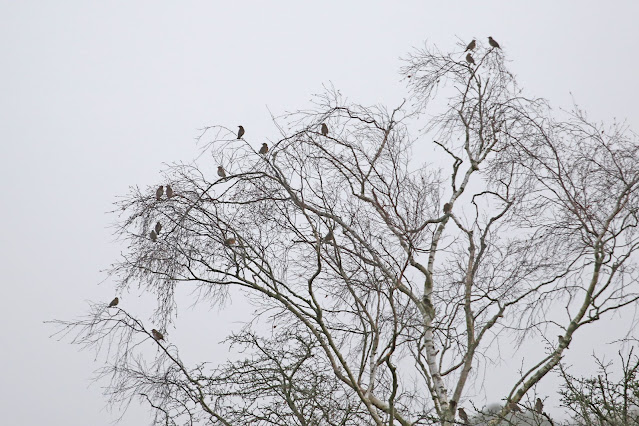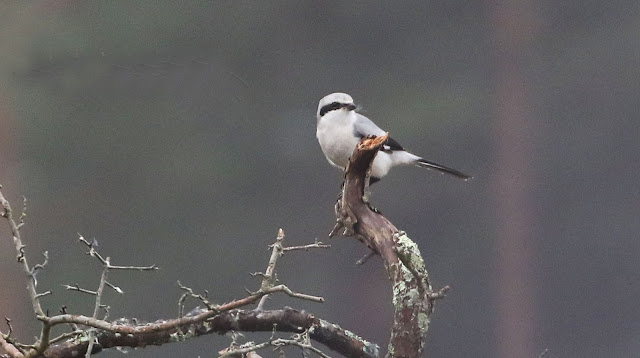It has been a long time since I have gone birding on Christmas Eve, but(and I apologise for this) I was hoping for a few presents! An early start, well dark start saw me pulling up at where we left off the previous Saturday, Roger Penny Way and the parking area near Black Gutter Bottom.
Having failed to see the male Hen harrier go to roost last Saturday, well in truth missed it because it was early, we had decided to try and catch it leaving the roost. We had been informed it was an early riser, but were taking no chances and had arrived at least 40 minutes before the sun was due to rise. Setting off from the cars it was still dark but as we walked down the slope and then along the ridge to view the spot where it was supposed to roost the light began to break through.
Away to the west of the Gutter mist was gathering in the valley bottom, the area probably flooded with warmer water than the surrounding air.
Four Ravens passed overhead calling, probably just having left the roost, while lone crows flew along the bottom. Then I picked up a bird just above the ridge on the left hand side of the path, the time was just 08:00 and as it dropped below the horizon it turned from a dark shape to a grey bird, the male Hen Harrier. Unfortunately it continued along the ridge away from us so all we could do was watch it drift characteristically away, off on its days hunting. It is believed that they cover a considerable distance in a day but return to their favoured roost site.
We decided to walk around the area in the hope that maybe we would come across it on the other side of the ridge. In contrast to the cold conditions of last week it was much milder and the ground was very wet and muddy. We crossed a rather full stream and came across a series of small waterfalls where last week it was all frozen. At the top of Leaden Hall the ground was flooded and Redwing and Fieldfare fed on the wet grass.
At the back of the plateau a Song Thrush was attempting to sing, but appeared to be sing the right notes but not necessarily in the right order, some more practice definitely required, but it is quite early yet.
The frost had definitely had an affect on the bracken, it was a red colour and clear all the fronds were dead.
There was probably a few more birds about than last week, Linnet overhead and Meadow Pipits, but unfortunately there was no sign of the hen Harrier. Coming along Ashley Walk we had a better view of the mist in Black Gutter Bottom.
Back at Leaden Hall the thrushes feeding on the grass were easily spooked, heading to the Hawthorn bushes.
Here twenty one Redwing settled in a Silver Birch, it reminds me of one of my Grandson's books where you have to be able to find them all
Heading back down towards the Stream we vowed to try again, this time maybe positioning ourselves on the footpath. We shall have to see, our record with Hen Harriers is not that good, but it was finally managing to at least see one, my 200th bird of the year.
Back at the cars we decided to try for another bird that seems to elude us lately. A few weeks ago we missed out on the Great Grey Shrike at Pig Bush, Ian in fact had also missed it the week before. Since then it disappeared only to return in the last week, clearly it was still about but just managed to avoid those looking for it.
Leaving the car park, I wasn't feeling confident, walking out on to the heath this became even more so, there were no birds about at all. On reaching the top of the ridge we scanned the area below us, there was a lot of water flowing freely through the marsh and around a clump of bushes, as I scanned the top of the bushes I noticed something pale on the top of one. I have mentioned before that when looking for Great Grey Shrikes, you seem to pick out anything, lichen, birch polypore or even a lighter or broken branch. On a closer look you realise it was never going to be a shrike.
This was the view I had, a pale form on top of the bush, the image in the middle of the frame, just next to the trunk of a birch.
Zooming in on the picture there was no doubt we had at last found the shrike, now could we get closer.
We headed down the path from the ridge and stopped as we went to continue to take record shots, shrikes can just disappear.
The path had a couple of bridges and as you can see there was a lot of water and watery sunshine to go with it.
We managed to walk across the heather and were able to get a little closer.
Our objective was to try and get around to the bushed with the sun behind us, but this meant having to negotiate a lot more water which was quite deep and prevented us from getting any closer.
You can get some idea of how quickly the water was flowing
One minute we could see the shrike then it was gone and we could not see where too. So it was back to scanning the area once more and having to deal with the pale and light shapes in the trees.
Was this it?
No, we think this was a patch of lichen
What about this?
Not sure what this was but it definitely was not the Great Grey Shrike.
Fortunately Ian was scanning behind us as we walked and he called out he had found it, about 250 metres away. It shows how they can move distances and you are not even aware they have done so. We half walked, half ran across the heather to get closer, there were some dog walkers passing in front of it, but fortunately the shrike was not bothered. We were able to use a large bush as cover and were able to get into position quite close.
Shrikes are a family of carnivorous birds with hooked beaks
like a bird of prey. They hunt large insects and small vertebrates, including
mammals, reptiles and other birds.
They are sometimes known as butcher birds for their habit of
impaling prey on thorns, barbed wire, or other suitable spikes. This helps hold
their food still so they can tear it up with their beak; it also serves as a
larder, where they can store food to eat later.
As
we watched the shrike it was clearly eating something, later we went back to this
bush and found a considerable number of feather that looked like they had
belonged to a Blue Tit.
A lovely background here.
It appeared to be wiping its bill on the branch
Then it flew and our hearts dropped, but it didn't leave instead flew to the top of a tree that was even closer to us. We were able to use the bush for cover still, but had to deal with the grey white background, even so I was able to get some of the best Great Grey Shrike photographs.
The
Great Grey Shrike is the largest shrike found in Europe, with a breeding range
that extends from France north to Norway and eastwards to Asia. Great Grey Shrikes
don't breed in the UK, but each year small numbers are seen during migration
periods, with some choosing to stay here over winter, although the numbers
arriving over the last few years has reduced significantly.
Great
Grey Shrikes are highly territorial, even defending feeding territories at
their wintering grounds, so are usually seen alone. This territory can be quite
large, with shrikes wandering over a wide area. They're usually found in open,
scrubby habitats where they perch at the very top of bushes and small trees, or
on fences.
Constantly scanning the area.
Then it flew back to the original tree, where it seemed to check the branches.
But then it was gone and flew quite a distance before perching at the top of what looked like a beech tree. This gives some idea of how much area it covers and also how manages to hide. The area around this tree was full of conifers and probably a good number of Coal and Blue Tits and Goldcrests, all likely prey.
Finally it was gone and we could not find it in any of the visible trees. We checked the larder tree, where as mentioned there were a lot of feathers, but nothing impaled on the hawthorn spikes. More than satisfied we headed back, taking in a small detour to watch a Mistle Thrush and to admire the colour of the grasses in the bog.
The colours looked even more impressive from the top of the ridge.
Where next? Well we decided to stay in the New Forest, but when we did so the sun was shining. The hope was that we could find two Tawny Owls enjoying the sun in the roost trees. Unfortunately as we pulled into the car park at Mark Ash, the sun had gone and it was threatening drizzle. True to form there was no sign of any Owls and in fact there were very few birds at all. We managed to find Great and Coal Tit feeding in the leaf litter and we heard a Nuthatch. A song Thrush was close to the car park when we arrived and there when we got back so we thought it only right to take the photograph.
With it now beginning to drizzle we decided to call it a day. We had managed to get two birds that have done their best to elude us over the last few years, the shrike was very obliging, the Hen Harrier very distant but recognisable, lets hope that can be changed in 2023, we have a plan, I think.













































No comments:
Post a Comment